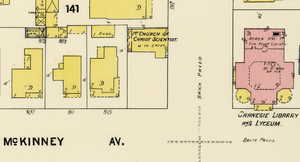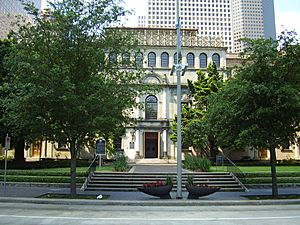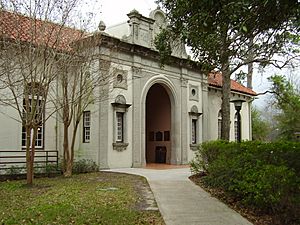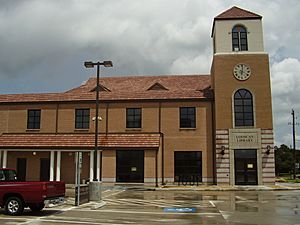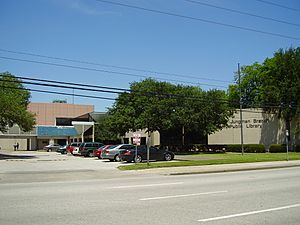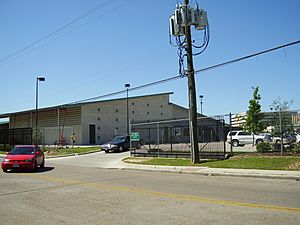Houston Public Library facts for kids
Quick facts for kids Houston Public Library |
|
|---|---|
 |
|
| Jesse H. Jones Building in Downtown Houston | |
| Country | United States |
| Established | 1904 |
| Branches | 44 |
| Collection | |
| Size | 3.6 million |
The Houston Public Library (HPL) is a big system of libraries in Houston, Texas. It helps people in the city find books, learn new things, and use computers. It's a public library, meaning it's open to everyone.
History of Houston's Libraries
Early Days and the Carnegie Library
The idea for the Houston Public Library started way back in 1854. This was when a group called the Houston Lyceum was formed. A lyceum was a place where people gathered to learn and discuss ideas. They had a library that eventually became its own separate place.
In 1892, a kind businessman named William Marsh Rice gave a lot of money, $200,000, to build a free public library. He also started Rice University. The library opened in 1895. In 1904, it got its own building with help from Andrew Carnegie, a famous philanthropist (someone who gives a lot of money to good causes).
Women in the city were very important in getting the library started. They knew how much the community needed a library. Julia Ideson became the first head librarian. The library started with 10,000 books. By 1907, 10,000 people in Houston had library cards! In 1921, the name changed from Carnegie Library to Houston Public Library. The library grew so much that it needed a bigger space.
The Julia Ideson Building
To get a bigger library, the old building was sold. A new, much larger building was finished in 1926. It cost $500,000 to build. The design of the building was inspired by Spanish architecture. It has cool carvings of explorers and missionaries from Texas history.
This new building opened with over 30,000 books. Later, it was named the Julia Ideson Building to honor Julia Ideson, the first librarian. It's still a very important part of the library system today.
The Carnegie Colored Library
When the first Carnegie Library opened, it was meant for everyone. However, African American educators were not allowed to use it in 1907. So, a group of African American educators, led by Ernest O. Smith, worked hard to get a library for their community.
The Colored Carnegie Library of Houston opened in 1913. It had its own African American leaders and staff. In 1921, it became a branch of the Houston Public Library system. This library closed in 1961 because it needed many repairs and was in the way of a new road project. A new library, the W. L. D. Johnson Library, opened in Sunnyside in 1964 to replace it.
Growing and Changing
The Houston Public Library system ended its racial segregation (separation of people by race) in 1953. Before this, African Americans could only use the Colored Carnegie Branch and a few other small locations. White people could use the main library and other branches.
This change happened after some important African American leaders in Houston spoke up. The Mayor of Houston, Roy Hofheinz, then told the library board that all library buildings should be open to everyone. So, on August 21, 1953, the libraries became open to all high school students and adults.
Today, the Houston Public Library system has 35 neighborhood libraries. It also has four larger regional libraries. The main library, called Central Library, is in Downtown Houston. It includes the historic Julia Ideson Building and the Jesse H. Jones Building, which was built in 1976.
The library system continues to grow and improve. New libraries have opened, and older ones have been updated. For example, the Jesse H. Jones Building was renovated and reopened in 2008.
Library Locations
Main Offices
The main offices for the Houston Public Library are in the Julia Ideson Building. This building was carefully restored and even had a new part added that was in the original design but wasn't built at first. This new part holds the Houston Metropolitan Research Center, which keeps important historical records for Houston.
Neighborhood Libraries
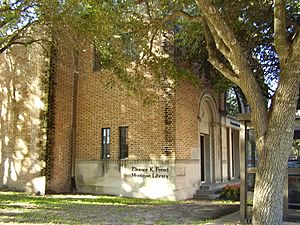
Besides the main Central Library and the Clayton Library for family history, there are 35 neighborhood libraries all over Houston. These libraries serve different parts of the city.
Here are some of the neighborhood libraries:
- Beulah Shepard-Acres Homes Neighborhood Library (Acres Homes)
- J. S. Bracewell Neighborhood Library (Southbelt/Ellington)
- Carnegie Neighborhood Library (Near Northside)
- Everett Collier Regional Library
- Amanda E. Dixon Neighborhood Library (Houston Gardens)
- Fifth Ward Neighborhood Library (Fifth Ward)
- Patricio Flores Neighborhood Library (Second Ward)
- Eleanor K. Freed-Montrose Neighborhood Library (Neartown)
- Heights Neighborhood Library (Houston Heights)
- David M. Henington-Alief Regional Library (Alief)
- Arnold L. Hillendahl Neighborhood Library (Spring Branch)
- W. L. D. Johnson Neighborhood Library (Sunnyside)
- J. Frank Jungman Neighborhood Library (Uptown)
- Belle Sherman Kendall Neighborhood Library (Memorial)
- Lakewood Neighborhood Library
- Adele Briscoe Looscan Neighborhood Library (River Oaks) - A new building for this library opened in 2007. It's much bigger than the old one and has lots of books and meeting rooms. It's also a "LEED-certified" building, which means it's designed to be good for the environment.
- Frank O. Mancuso Neighborhood Library
- Eva Alice McCrane-Kashmere Gardens Neighborhood Library (Kashmere Gardens)
- John P. McGovern-Stella Link Regional Library (Braeswood Place) - This library opened in 2005 and is named after a doctor, John P. McGovern. It's been called one of the best public library branches in Houston.
- Lucile Y. Melcher Neighborhood Library (Pecan Park)
- George B. Meyer Neighborhood Library (Meyerland/Westbury) - This library opened in 1962. After Hurricane Harvey in 2017, it was damaged and closed. A new library will be built to replace it.
- Nettie Moody Neighborhood Library (Northside)
- Oak Forest Neighborhood Library (Oak Forest)
- Park Place Regional Library (Park Place)
- Pleasantville Neighborhood Library (Pleasantville)
- Elizabeth L. Ring Neighborhood Library (Spring Branch)
- Judson W. Robinson-Westchase Neighborhood Library (Westchase)
- Scenic Woods Regional Library (Scenic Woods)
- Lonnie E. Smith Neighborhood Library (Third Ward)
- Nena Stanaker Neighborhood Library (Magnolia Park)
- Sherman E. Stimley-Blue Ridge Neighborhood Library (Blue Ridge)
- Cliff Tuttle Neighborhood Library (Denver Harbor)
- William A. Vinson Neighborhood Library
- M. E. Walter Neighborhood Library (Sharpstown)
- Alice McKean Young Neighborhood Library (Palm Center, near South Park)
Special Libraries
These libraries focus on specific topics:
- African American Library at the Gregory School - This library focuses on African American history and culture.
- Clayton Library Center for Genealogical Research - This library helps people research their family history.
- Houston Metropolitan Research Center - This center keeps important historical documents and records about Houston.
Former Locations
- Colored Carnegie Library - This library opened in 1912 and closed in 1961.
Partnership Libraries
The Houston Public Library also works with other library systems. For example, they partner with the Harris County Public Library for the Clear Lake City-County Freeman Branch Library.
The Parent Resource Library at the Children's Museum of Houston is also part of the HPL system. Its staff are employed by the museum.
HPL Express Locations
HPL Express locations are smaller library spots found inside other buildings. They usually have books, computers, and a classroom.
Some Express locations include:
- HPL Express Discovery Green
- Morris Frank Library, an HPL Express Location (Fondren Southwest)
- HPL Express Southwest
- HPL Express Vinson
HPL Mobile Express
The HPL Mobile Express is like a library on wheels! It's a mobile lab that helps people learn computer skills.
Images for kids
-
Oak Forest Neighborhood Library
-
Clayton House of the Clayton Library, Center for Genealogical Research in the Houston Museum District
See also
 In Spanish: Biblioteca Pública de Houston para niños
In Spanish: Biblioteca Pública de Houston para niños


